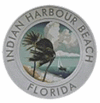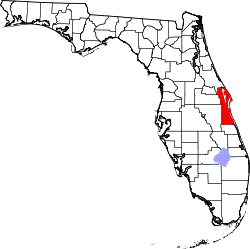Indian Harbour Beach, Florida
| Indian Harbour Beach, Florida | ||
|---|---|---|
| City | ||
| City of Indian Harbour Beach | ||
|
Indian Harbour Beach Skyline | ||
| ||
| Motto: "The Greatest Little City in Florida!" | ||
 Location in Brevard County and the state of Florida | ||
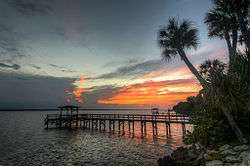 | ||
| Coordinates: 28°9′7″N 80°35′42″W / 28.15194°N 80.59500°WCoordinates: 28°9′7″N 80°35′42″W / 28.15194°N 80.59500°W | ||
| Country |
| |
| State |
| |
| County |
| |
| Area | ||
| • Total | 2.6 sq mi (6.8 km2) | |
| • Land | 2.1 sq mi (5.5 km2) | |
| • Water | 0.5 sq mi (1.3 km2) | |
| Elevation | 10 ft (3 m) | |
| Population (2010) | ||
| • Total | 8,225 | |
| • Density | 3,200/sq mi (1,200/km2) | |
| Time zone | Eastern (EST) (UTC-5) | |
| • Summer (DST) | EDT (UTC-4) | |
| FIPS code | 12-33450[1] | |
| GNIS feature ID | 0284502[2] | |
| Website |
www | |
Indian Harbour Beach is a city in Brevard County, Florida. The population was 8,225 at the 2010 United States Census.[3] It is part of the Palm Bay–Melbourne–Titusville Metropolitan Statistical Area. It is 3 miles (4.8 km) north of the town of Indialantic and south of Satellite Beach. It is the first and only community in the United States to be a NOAA Tsunami Ready community along the nation's East Coast.[4]
Geography
According to the United States Census Bureau, the city has a total area of 2.6 square miles (6.7 km2). 2.1 square miles (5.4 km2) of it is land and 0.5 square miles (1.3 km2) of it (18.63%) is water.
Climate
Indian Harbour Beach is located in the region where tropical and temperate climatic zones interface. Daytime temperatures average 90 °F (32 °C) in the summer months and 72 °F (22 °C) in the winter months.[5] A study commissioned by NASA[6] lends credence to the notion that Indian Harbour Beach is located in a portion of the North American Atlantic shoreline with a uniquely reduced incidence of catastrophic hurricanes.[7]
Fauna
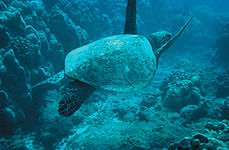
Threatened Atlantic loggerhead sea turtles nest on the city's ocean beaches at densities of approximately one nest per 10 feet (3.0 m) of shoreline per year. Endangered green sea turtles deposit an average of tens of nests along the city's ocean beach each year.
Endangered right whales calve off the city's shoreline. Endangered West Indian manatees frequent the city's canals and the Banana River. Bald eagles forage over Samsons Island.
The 12 acres (4.9 ha) of wetland created as mitigation by a local developer on Samsons Island provide nutrient-rich, sheltered aquatic habitat serving as finfish nursery and feeding ground for a diverse assemblage of birds and mammals. The city established Samsons Island Nature Park, the only gopher tortoise relocation recipient site on the barrier island. It is occupied by 42 relocated tortoises and three which had been living on the island when development began. The city has erected five osprey nesting platforms on Samsons Island Nature Park, from which young have been fledged. Efforts are now under way to create habitat for use by gopher tortoises and scrub jays. The city is working with faculty of the Florida Institute of Technology to promote graduate student research and class projects on Samsons Island Nature Park and to assist in devising and implementing maintenance programs to preserve and enhance desirable wildlife habitats.[8]
Flora
Due to the moderating influence of surrounding water bodies, the climate on Indian Harbour Beach and the barrier island on which it is situated supports rare tropical species of plants normally found far to the south. Brevard County's barrier island to, approximately, Cape Canaveral, constitutes the northernmost limit of the range of many of these plant and flower species. At the same time, the infrequency and mildness of freezes in the Central Florida region in general serves to define the southern limit of many of the unique plants found in temperate zones. Thus, the barrier island in the vicinity of Indian Harbour Beach represents an unusual climatological region which sustains unique habitats characterized by mixed tropical and temperate plant species, in addition to a significant number of endemic species only found in the local region.[9]
There are plant species which now grow naturally, or were present prior to development, within the boundaries of Indian Harbour Beach.[10] Vegetated sand dunes are found along most of the beach's length and provide the major defense against storm events in the region. Native plant species found on the dunes include sea oats, Sabal palmetto, sea grape, railroad vine, dollar weed, coral bean, Spanish bayonet, wax myrtle, yaupon holly, and several grass species. More salt-tolerant and wind-tolerant species, such as sea oats and railroad vine, are found predominantly on the ocean side of the dune, while other dune vegetation species do not generally show such zonation. These plants assist in building the dune by trapping windblown sand and in stabilizing the dune with extensive lateral root systems.
Geology
There are approximately 10 acres (4.0 ha) of coquina rock outcrops frequently exposed along the low-tide line of Indian Harbour's ocean beach. The National Marine Fisheries Service has classified the rock as an Essential Fish Habitat-Habitat Area of Particular Concern. It is important to aquatic life and found only in a few locations along the Eastern seaboard.
On the Indian Harbour's ocean beach can be found fossil Atlantic ghost crabs, the remnants of a unique set of geological circumstances which preserved these creatures when they died in their burrows perhaps about 110,000 years ago.
There are significant deposits of sand, marl, coquina and possibly phosphate within the limits of Indian Harbour Beach. There are no mining operations, as municipal zoning regulations prohibit mineral extraction.
Surrounding areas
- Merritt Island; Indian River Lagoon; Banana River; Melbourne

- Atlantic Ocean

- Melbourne

- Satellite Beach

Government
In 2007, the city had a taxable real estate base of $920.7 million.[11]
Demographics
| Historical population | |||
|---|---|---|---|
| Census | Pop. | %± | |
| 1970 | 5,371 | — | |
| 1980 | 5,967 | 11.1% | |
| 1990 | 6,933 | 16.2% | |
| 2000 | 8,152 | 17.6% | |
| 2010 | 8,225 | 0.9% | |
| Est. 2015 | 8,471 | [12] | 3.0% |
As of the census[1] of 2000, there were 8,152 people, 3,762 households, and 2,381 families residing in the city. The population density was 1,470.8/km² (3,810.1/mi²). There were 4,315 housing units at an average density of 778.5/km² (2,016.7/mi²). The racial makeup of the city was 95.40% White, 0.93% African American, 0.28% Native American, 1.57% Asian, 0.04% Pacific Islander, 0.55% from other races, and 1.23% from two or more races. Hispanic or Latino of any race were 3.28% of the population.
There were 3,762 households out of which 21.9% had children under the age of 18 living with them, 50.8% were married couples living together, 9.5% had a female householder with no husband present, and 36.7% were non-families. 30.6% of all households were made up of individuals and 15.0% had someone living alone who was 65 years of age or older. The average household size was 2.17 and the average family size was 2.69.
The population was distributed by age with 18.5% under the age of 18, 5.4% from 18 to 24, 23.6% from 25 to 44, 27.5% from 45 to 64, and 24.9% who were 65 years of age or older. The median age was 46 years. For every 100 females there were 90.1 males. For every 100 females age 18 and over, there were 87.0 males.
The median income for a household in the city was $42,889, and the median income for a family was $56,803. Males had a median income of $50,045 versus $29,697 for females. The per capita income for the city was $29,986. About 2.3% of families and 5.5% of the population were below the poverty line, including 4.3% of those under age 18 and 2.2% of those age 65 or over.
Education
In 2010, the town had the highest percentage of people with undergraduate degrees of any municipality measured in the county, 41%, compared with an average of 26% countywide.[14]
History
Indian Harbour Beach was founded on June 6, 1955, by W. Lansing Gleason, John H. Neafie and Louis S. Henry. Along with Palm Beach and Sanibel, Indian Harbour Beach ranks among the top 3 places to live in Florida according to AreaVibes livability score.[15]
Education
There is one elementary school, Ocean Breeze Elementary. In 2009, it scored 11th in the state on the FCAT test.[16]
- Private schools:
- Chabad Hebrew School
- Torah Academy Preschool.[17]
Recreation
Nearby are several parks, recreational facilities and natural landscapes.
The Indian Harbour Beach Recreation Center is located in 27-acre Gleason Park on the corner of South Patrick Drive and Yacht Club Boulevard. The Recreation Department offers a wide variety of classes, services and activities, ranging from those for toddlers and preschoolers, to a Senior Leisure-time Club. Also located in the park is the City’s heated competition-size swimming pool – open seven days a week year-round, shuffleboard courts, two playgrounds, a walking/exercise trail and picnic facilities.[18]
The million-dollar Algonquin Sports Complex located off Wimico Drive is home to senior baseball, major Little League, softball and soccer fields serving multiple age groups. Other city ball fields are located next to Ocean Breeze School and serve minor Little League teams as well as T-ball participants. Some of the special activities offered through our Recreation Department include the annual Art & Crafts Show held the third Saturday in November, the annual Breakfast With The Easter Bunny, and numerous pool activities including American Red Cross instructed summer swim lessons.[18]
In 2013, Hightower Beach Park was renovated by a community partnership with Montecito Community Development District and state funds from the Florida Preservation 2000 and Florida Land and Water grant programs. The 15 acres (6.1 ha) park contains the natural dune system and has a boardwalk along the coastline. Surfers use the beach.
RC's Beach and Buccaneer Beach are named for a former Royal Castle hamburger kiosk and the Buccaneer Condos, respectively. They are used for surfing.[19]
Coconut Point Park is a 36.9-acre (14.9 ha) community beachside park and sea turtle nesting site. The park is listed in the state of Florida Great Florida Birding Trail. Shorebirds include black-bellied plovers, red knots (winter), gannets, seabirds (offshore), and red-throated loons (winter).
The David R. Schechter Community Center is a recreational community center. It hosts gatherings, community special events, classes, programs, and other activities. | url+http://www.satellitebeachrecreation.org/Pages/DavidRSchechterCommunityCenter.aspx
DeSoto Park features eight tennis courts as well as two enclosed racquetball courts.
Samsons Island is a 52-acre (21 ha) park. It was renovated from an island overrun with exotic plants. Volunteers have worked since 1991 to develop it. It is only accessible by boat. There are butterflies, gopher tortoises, armadillos, squirrels and snakes — black racers and coachwhips. There are 30 species of birds. The island contains trails, bird watching, camping areas, wildlife, and picnic areas.[20] Samsons Island has trails for biking and hiking.
Gemini Beach Park is a 2 acres (0.81 ha) park nestled between Ellwood and Park Avenue and contains dunes, sea turtles, and birdlife.[21]
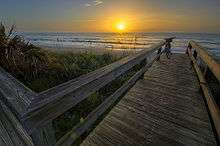
Public safety
The National Weather Service has named Indian Harbour Beach the first "tsunami-ready" city in Florida.[22]
The city has a 100% Volunteer Fire Department, consisting of 30+ members and utilizing three Class-A pumpers, including a 75 feet (23 m) ladder truck.[23]
Notable people
- Larry Guarino, spent 8 years as a POW in the Hanoi Hilton during the Vietnam War
- Jim Rathmann, 1960 Indianapolis 500 winner
- Tim Wakefield, Major League Baseball player[24]
See also
References
- 1 2 "American FactFinder". United States Census Bureau. Archived from the original on September 11, 2013. Retrieved January 31, 2008.
- ↑ "US Board on Geographic Names". United States Geological Survey. October 25, 2007. Retrieved January 31, 2008.
- ↑ "Profile of General Population and Housing Characteristics: 2010 Demographic Profile Data (DP-1): Indian Harbour Beach city, Florida". U.S. Census Bureau, American Factfinder. Archived from the original on September 11, 2013. Retrieved January 30, 2012.
- ↑ http://www.noaanews.noaa.gov/stories2005/s2470.htm
- ↑ "Weather". AccuWeather.com. Retrieved February 20, 2014.
- ↑ published in June 2000 (Wind and Flood Hazard Assessment of Critical NASA Assets at the Kennedy Space Center)
- ↑ Archived August 30, 2006, at the Wayback Machine.
- ↑ http://ntrs.nasa.gov/archive/nasa/casi.ntrs.nasa.gov/20000104994.pdf
- ↑ http://www.satellitebeach.org/boards/cpab/CompPlan/D&A%205%20Coastal%20Management-Conservation%20Element.doc. Retrieved August 3, 2015. Missing or empty
|title=(help) - ↑ https://www.municode.com/library/fl/indian_harbour_beach/codes/code_of_ordinances?nodeId=CD_ORD_INDIAN_HARBOUR_BEACH_FLORIDA
- ↑ Dean, James (April 26, 2008). More taxes or fewer services. Florida Today.
- ↑ "Annual Estimates of the Resident Population for Incorporated Places: April 1, 2010 to July 1, 2015". Retrieved July 2, 2016.
- ↑ "Census of Population and Housing". Census.gov. Archived from the original on May 11, 2015. Retrieved June 4, 2015.
- ↑ Ryan, MacKenzie (December 15, 2010). "Census data notes makeup of towns". Melbourne, Florida: Florida Today. pp. 1A.
- ↑ http://carpenterkessel.com/indian-harbour-beach-ranked-3-place-to-live-in-florida/
- ↑ White, George (November 1, 2009). "Parade mark FCAT success". The South Beaches Breeze. Melbourne, Florida: Florida Today. p. 28.
- ↑ Hebrew School - Chabad of the Space & Treasure Coasts. Jewishbrevard.com. Retrieved on September 18, 2013.
- 1 2 http://www.indianharbourbeach.org/parks-and-rec-dept/
- ↑ "Central Florida Surfing". TheSurfingSite.com. 2008. Retrieved June 10, 2014.
- ↑ "Local News - FLORIDA TODAY - floridatoday.com". FLORIDA TODAY. Retrieved November 17, 2014.
- ↑ "Beach Parks". Satellitebeachrecreation.org. Retrieved December 12, 2013.
- ↑ NOAA News Online (Story 2470)
- ↑
- ↑
External links
| Wikimedia Commons has media related to Indian Harbour Beach, Florida. |

